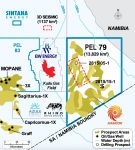New data from the Namibia Statistics Agency (NSA) reveals stark regional disparities in the cost of living, with northern Namibia bearing the brunt of rising food prices while other zones grapple with their own unique inflationary pressures. The June 2025 Namibia Consumer Price Index (NCPI) bulletin highlights how inflation is playing out unevenly across the country’s three economic zones, painting a picture of affordability challenges that vary dramatically depending on where consumers live.
Zone 1, encompassing the northern regions of Kavango East, Kavango West, Kunene, Ohangwena, Omusati, Oshana, Oshikoto, Otjozondjupa, and Zambezi, recorded the highest annual inflation rate at 3.9%, outpacing both Zone 2 (Khomas) at 3.3% and Zone 3 (//Kharas, Erongo, Hardap, and Omaheke) at 3.7%. While inflation has eased slightly compared to last year, the pain points for consumers differ sharply by region, with food, housing, and transport costs driving the most significant financial strain.
A closer look at food prices reveals troubling trends, particularly in Zone 1. Basic staples such as white bread flour (2.5kg) cost N$49.66 in the north, compared to N$53.21 in Khomas and N$51.99 in Zone 3. While this might suggest lower costs for northern consumers, the reality is more complex. Maize meal (5kg), a dietary staple, is significantly more expensive in Zone 1 at N$79.32, while Khomas residents pay N$70.87. This discrepancy suggests that while some goods are cheaper in the north, essential carbohydrates—critical for low-income households—are costing families more.
Meat prices tell a similar story. Beef stew per kilogram is priced at N$105.74 in Zone 1, slightly below Khomas’ N$107.19 but far cheaper than Zone 3’s N$113.52. However, beef mince is more expensive in the north at N$114.12 per kg compared to N$114.41 in Zone 3, indicating that affordability varies even within the same food category. Fish, another key protein source, is also hitting wallets harder in some regions than others. Tinned pilchards in tomatoes (400g) cost N$33.42 in Zone 1, while Khomas and Zone 3 pay N$36.16 and N$36.88 respectively. This suggests that while processed fish is more affordable in the north, fresh and frozen options—critical for nutrition—may be subject to different pricing pressures.
Vegetable inflation is another major concern, particularly for households in Zone 1. Fresh tomatoes sell for N$44.85 per kg in the north, slightly below Khomas’ N$47.39 and Zone 3’s N$46.04. However, onions—a kitchen staple—are more expensive in Zone 1 at N$25.98 per kg compared to Zone 3’s N$24.22. These fluctuations highlight how regional supply chains, transportation costs, and local demand are creating pockets of higher food inflation, disproportionately affecting lower-income families who spend a larger share of their income on essentials.
Beyond food, other consumer goods reveal further disparities. Red wine (750ml) is far cheaper in Zone 3 at N$52.12, while Khomas pays N$80.49 and Zone 1 N$70.23. Meanwhile, white wine is most expensive in Zone 3 at N$81.39, compared to N$62.67 in the north. While alcohol may seem like a discretionary spend, these price differences reflect broader trends in distribution costs and retail markups that also apply to essential goods.
Transport costs, a critical factor in overall inflation, also vary by zone. Petrol prices are nearly uniform, with Zone 1 paying N$21.03 per litre, Khomas N$20.86, and Zone 3 N$21.00. Diesel follows a similar pattern, with marginal differences. However, the broader transport category—which includes vehicle purchases and maintenance—has seen deflation in all zones, with Zone 3 experiencing the sharpest drop at -3.4%. This suggests that while fuel prices remain stable, other transport-related expenses are easing, potentially offering some relief to consumers.
Housing and utilities, which make up the largest share of the NCPI basket at 28.4%, show another layer of regional inequality. Rental inflation has surged, particularly in Zone 1, where housing costs have risen alongside food prices, squeezing household budgets from multiple angles. Water and electricity costs have also climbed, further straining disposable incomes in regions where wages have not kept pace with inflation.
The NSA’s zonal breakdown underscores a critical reality: inflation is not a uniform experience. While national headlines focus on the 3.7% headline rate, the lived reality for Namibians depends heavily on where they live, what they consume, and how local supply chains function. For policymakers, this means targeted interventions—such as subsidies for maize meal in the north or improved transport infrastructure to reduce food distribution costs—could be more effective than broad economic measures.
As Namibia navigates these inflationary pressures, the June 2025 NCPI serves as a reminder that economic stability cannot be measured by a single national figure. For families in Zone 1, where food and housing costs are rising fastest, the challenge is not just inflation—it’s affordability. And until regional disparities are addressed, many households will continue to feel the pinch more sharply than others.










